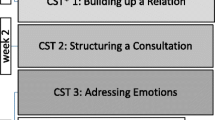Abstract
Communication is important in clinical interaction; thus medical students require communication skills training. Most training programs focus on developing students’ verbal skills, and nonverbal communication is not given sufficient attention. This paper describes a tele-health training platform EQClinic, which has the capability of automatically detecting nonverbal behaviour in tele-consultations and providing medical students with human and computer-generated feedback for improving their communication skills. In this paper, we describe EQClinic’s components and report preliminary results from an 8-week user study with 135 medical students. The students were provided two opportunities of having face-to-face consultation, and between these two consultations students were also asked to complete a tele-consultation using EQClinic. Student found the system usable and their scores in the second face-to-face consultations improved after the tele-consultation (from 12.58 to 13.53, p = 0.005). The results suggest that EQClinic positively influenced medical students’ learning and may be a valuable tool in medical education.
Access this chapter
Tax calculation will be finalised at checkout
Purchases are for personal use only
Similar content being viewed by others
References
Chung, S.C., Barma, S., Kuan, T.-W., Lin, T.-W.: Frowning expression detection based on SOBEL filter for negative emotion recognition. In: 2014 IEEE International Conference on Paper Presented at the Orange Technologies (ICOT), Xi’an (2014)
Fukkink, R.G., Trienekens, N., Kramer, L.J.: Video feedback in education and training: Putting learning in the picture. Educ. Psychol. Rev. 23(1), 45–63 (2011)
Fung, M., Jin, Y., Zhao, R., Hoque, M.E.: ROC speak: semi-automated personalized feedback on nonverbal behavior from recorded videos. In: Paper Presented at the Proceedings of the 2015 ACM International Joint Conference on Pervasive and Ubiquitous Computing, Osaka (2015)
GENKI-4 K: The MPLab GENKI Database, GENKI-4 K Subset. http://mplab.ucsd.edu
Gorawara-Bhat, R., Cook, M.A., Sachs, G.A.: Nonverbal communication in doctor–elderly patient transactions (NDEPT): development of a tool. Patient Educ. Couns. 66(2), 223–234 (2007)
Hoque, M.E., Courgeon, M., Martin, J.-C., Mutlu, B., Picard, R.W.: Mach: my automated conversation coach. In: Paper Presented at the Proceedings of the 2013 ACM International Joint Conference on Pervasive and Ubiquitous Computing, Zurich (2013)
Ishikawa, H., Hashimoto, H., Kinoshita, M., Yano, E.: Can nonverbal communication skills be taught? Med. Teach. 32(10), 860–863 (2010)
Jang, J.S.R.: Utility Toolbox (2016). http://mirlab.org/jang
Kawato, S., Ohya, J.: Real-time detection of nodding and head-shaking by directly detecting and tracking the “between-eyes”. In: Fourth IEEE International Conference on Paper Presented at the Automatic Face and Gesture Recognition, 2000, Proceedings, Grenoble (2000)
Liu, C., Calvo, R.A., Lim, R.: Improving medical students’ awareness of their nonverbal communication through automated nonverbal behavior feedback. Front. ICT 3(11) (2016)
Lucey, P., Cohn, J.F., Kanade, T., Saragih, J., Ambadar, Z., Matthews, I.: The extended cohn-kanade dataset (ck+): a complete dataset for action unit and emotion-specified expression. In: 2010 IEEE Computer Society Conference on Paper Presented at the Computer Vision and Pattern Recognition Workshops (CVPRW), San Francisco (2010)
Novack, D.H., Cohen, D., Peitzman, S.J., Beadenkopf, S., Gracely, E., Morris, J.: A pilot test of WebOSCE: a system for assessing trainees’ clinical skills via teleconference. Med. Teach. 24(5), 483–487 (2002)
Paul, S., Dawson, K., Lanphear, J., Cheema, M.: Video recording feedback: a feasible and effective approach to teaching history-taking and physical examination skills in undergraduate paediatric medicine. Med. Educ. 32(3), 332–336 (1998)
Simmenroth-Nayda, A., Heinemann, S., Nolte, C., Fischer, T., Himmel, W.: Psychometric properties of the Calgary Cambridge guides to assess communication skills of undergraduate medical students. Intl. J. Med. Educ. 5, 212 (2014)
Smith, L.I.: A tutorial on principal components analysis. Cornell Univ. USA 51(52), 65 (2002)
Stewart, M.A.: Effective physician-patient communication and health outcomes: a review. CMAJ Can. Med. Assoc. J. 152(9), 1423 (1995)
Vinciarelli, A., Pantic, M., Bourlard, H.: Social signal processing: survey of an emerging domain. Image Vis. Comput. 27(12), 1743–1759 (2009)
Viola, P., Jones, M.: Rapid object detection using a boosted cascade of simple features. In: Proceedings of the 2001 IEEE Computer Society Conference on Paper Presented at the Computer Vision and Pattern Recognition, 2001, CVPR 2001, Kauai (2001)
Wei, Y.: Research on facial expression recognition and synthesis. Master Thesis, Department of Computer Science and Technology, Nanjing (2009)
Acknowledgements
This project was funded by an internal grant from the Brain and Mind Centre at the University of Sydney, Australia and Australian Government. RC is funded by the Australian Research Council.
Author information
Authors and Affiliations
Corresponding author
Editor information
Editors and Affiliations
Rights and permissions
Copyright information
© 2016 Springer International Publishing AG
About this paper
Cite this paper
Liu, C., Calvo, R.A., Lim, R., Taylor, S. (2016). EQClinic: A Platform for Improving Medical Students’ Clinical Communication Skills. In: Yin, X., Geller, J., Li, Y., Zhou, R., Wang, H., Zhang, Y. (eds) Health Information Science. HIS 2016. Lecture Notes in Computer Science(), vol 10038. Springer, Cham. https://doi.org/10.1007/978-3-319-48335-1_8
Download citation
DOI: https://doi.org/10.1007/978-3-319-48335-1_8
Published:
Publisher Name: Springer, Cham
Print ISBN: 978-3-319-48334-4
Online ISBN: 978-3-319-48335-1
eBook Packages: Computer ScienceComputer Science (R0)



